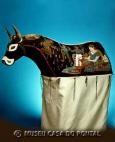NEARBY LOCATIONS
LOCAL ARTISTS
WORKED THEMES
São Luiz - MA
The city of São Luis is the only Brazilian capital built completely on an island, situated in the northern region of Maranhão State, with a population estimated at 1,027,429 (IBGE, CNM, 2011). At the end of the 1990s, its historical centre was classified by UNESCO as a Cultural Heritage of Humanity. Dating from 1612, this is the only Brazilian city founded by the French, hence its name: in homage to the King of France Louis XIII at that time. As a major river and sea port, the capital of Maranhão played a leading role in the economic production of the colonial period until the 19th century (IBGE, 2011). Today, the city is also known for its June festivities, where the bumba-meu-boi or ox revelries are a highlight, and which is taken as the emblem of Maranhão. But it has not always been like that since this revelry only occurred over the years in the suburbs of São Luis and towns in the interior. It was in the 1960s when it reached the upper classes in the capital that it achieved greater projection. This is one of Brazil’s most traditional festivals, existing in almost every region. According to Carvalho (2005), in São Luis alone there are around 200 groups of bumba-meu-boi. The author stresses that in Maranhão the ox festival appears in local styles called accents [sotaques] “to which rhythmic and musical styles as well as the characters, costumes, forms of social organisation, choreographic patterns and specific territories correspond”” (ibidem: 2). So there are five predominant accents in Maranhão: zabumba [bass drum]; costa-de-mão [small tambourines played with the back of the hand; matraca [rattles], orchestra and baixada. It is in the context of an ox from the baixada [plains], the Forest Ox, that the work of Abel Teixeira became famous (Van de Beuque, 2010). Abel, born in 1939 in the region of the Maranhão plains, played the role of Cazumba in this revelry and is an artisan of masks for this character, with remarkable features, known as “Cazumba’s faces”. In 2009 the Ministry of Culture awarded him the prize of Master of Folk Culture. His “masks” are displayed in the collection of a number of Brazilian museums and in the Bragança Mask Museum in Portugal (Van de Beuque, 2010). The same universe of the bumba-meu-boi highlights another major artist from Maranhão: Nhozim, registered as Antonio Bruno Pinto Nogueira. He was born in 1904 in Bacuripanã, and moved to the capital when he was 32 years old after the death of his parents. The artist is considered the first to make ox figures in São Luis. Nhozim died in 1974, victim of a disease contracted in adolescence.


